#Augusto Tamayo
Text
Colombian Roll 4.0
Entrevistas especiales con: Santiago Prieto de Monsieur Perine, Augusto Tamayo, el Canto al Llano de Emmanuel Briceño director musical de Juanes, y Daniel Álvarez de Diamante Eléctrico.
#Augusto Tamayo#Colombian-Roll#Daniel Alvarez#Diamante Electrico#Emmanuel Briceño#Monsieur Perine#Santiago Prieto
0 notes
Text

"You are above the infinite sea".
Augusto Tamayo Vargas.
Fotografía: MAVi. "Parque del Amor". Lima, Perú.
Sueños y fantasmas. El arte de soñar.
62 notes
·
View notes
Text

#ProyeccionDeVida
🎬 “LA HERENCIA DE FLORA” 👩🌸
🔎 Género: Drama / Biográfico / Histórico / Siglo XIX
⏰ Duración: 100 minutos

✍️ Guión: Jimena Ortiz de Zevallos y Augusto Tamayo San Román
🎼 Música: Miguel Figueroa y Víctor Villavicencio
📷 Fotografía: Juan Durán

🗯 Argumento: Flora Tristán, una mujer valiente, escapa de los maltratos en Francia para reclamar su herencia en el Perú. A pesar de la traición de su tío, descubre las injusticias sociales y la esclavitud. De regreso en Francia, se convierte en escritora y defensora de los derechos de obreros y mujeres. En su vida, experimenta el amor, incluso con Olympe Chodzko, pero elige renunciar al romance para dedicarse por completo a su lucha por la igualdad y la justicia. Su historia es un testimonio de valentía y dedicación a una causa mayor.
👥 Reparto: Diego Bertie (Captain Chabrié), Vanessa Saba, Jimena Lindo, Paloma Yerovi Cisneros (Flora Tristán), Vania Accinelli (Dominga Gutiérrez), Mónica Spanchez, Joaquín de Orbegoso, Silvia Cañote, Bruno Odar, Alberto Isola y Gonzalo Revoredo (Coronel Escudero)
📢 Dirección: Augusto Tamayo San Román

© Productora: Argos Producciones Audiovisuales
🌎 País: Perú
📅 Año: 2024
▶️Video Promocional: https://youtu.be/GuXwrqPWrwE

🎥 Proyecciónes:
📆Jueves 05 de Setiembre 🕖 7:00pm. / Sábado 07 de Setiembre 🕕 6:00pm.
🎦 Sala Lumiere de la Alianza Francesa (av. Arequipa 4595 - Miraflores)

🎫 Entrada: S/.5
🖱 Reservas: https://bit.ly/CineAFLima
0 notes
Text

La Herencia de Flora la película dirigida por Augusto Tamayo lanza afiche oficial http://dlvr.it/T1h0pq
0 notes
Text
97 AÑOS DE LA SUBLEVACIÓN CAMPESINA DE HUANCHO LIMA #huanchoLima
Fernando Chuquipiunta
La llamada sublevación campesina de Wancho Lima, fue registrada por José Carlos Mariátegui, Jorge Basadre, Wilfredo Kapsoli, Manuel Scorza, Pablo Macera, José Tamayo Herrera, Teobaldo Loayza Obando, Augusto Ramos Zambrano y José Luis Rénique. La frondosa documentación data desde la época de los mensajeros, quienes viajaron a Lima para reclamar al presidente Manuel Gonzáles Candamo, acerca de los abusos de los gamonales de Huancané contra los campesinos quechuas y aymaras.
Debido al liderazgo de Carlos Condorena Yujra, llamado también Carlosín Condorena, cuyo verdadero nombre era Carlos Condori Yujra, es que se formó un grupo de personas decididas a acabar con el gamonalismo en el departamento de Puno. Evaristo Corimayhua Carcasi, Mariano Luque Corimayhua, Pedro Nina Cutipa Corimayhua, Melchor Cutipa Luque, Antonio Francisco Luque Luque, Mariano Mercedes Pacco Mamani y Rita Puma, se convirtieron en líderes de un movimiento que, además, se propuso establecer una educación bilingüe, como recuperar las tierras arrebatadas por los gamonales a las comunidades campesinas.
En un principio contaron con la simpatía del presidente Augusto Bernandino Leguía y Salcedo, quien auspiciaba desde el gobierno un indigenismo oficial y subalterno. Los dirigentes de Huancho decidieron entonces, construir una ciudad con los mismos planos urbanos de Lima y le pusieron el nombre de Huancho Lima, capital de la República Aymara Tahuantisuyana y lugar emblemático de la reivindicación de los derechos ciudadanos de la cultura aymara. Construyeron locales para ministerios, escuelas, mercados, calles y avenidas.
Todo estaba decidido para atacar a Huancané y diezmar a la población. Pero ese hecho fue impedido por las lluvias que provocaron que el río Huancané creciera, arrastrando muchas balsas llenas de personas. El domingo 16 de diciembre de 1923, a las 10 de la mañana, muchas personas murieron a causa de las balas de fusiles y ametralladoras, también se produjo un gran incendio de todas las casas de Huancho.
Nunca se supo cuántos muertos hubo. El éxodo fue enrome y ese acontecimiento ha sido registrado magistralmente por el escritor huancaneño José Luis Ayala Olazával, quien ha publicado: Wancho Lima (cronivela), Yo fui canillita de José Carlos Mariátegui. (Auto) biografía de Mariano Larico Yujra (testimonio), Fusilamiento y resurrección de Mariano Paqo (novela corta), Celebración cósmica de Rita Puma (poesía), El presidente Carlos Condorena Yujra (historia) y Saturnino Corimayhua. Testimonio de lucha de un campesino del siglo XX (entrevista).
Además, sin la contribución de Vicente y Julio Mendoza Díaz, Leonidas Cuentas Gamarra, Juan Luis Ayala Loayza, Felipe Sánchez Huanca, Augusto Ramos Zambrano, Leoncio Mamani Coaquira, Julio Volodia Mendoza Aparicio, pero especialmente de José Luis Ayala Olazával, sin duda que se hubiera perdido tanta información histórica. Las nuevas generaciones tienen derecho a conocer el pasado para que no se repitan los mismos errores. Finalmente, no hay pueblo sin historia porque sin ella no es posible, edificar un futuro distinto al oprobioso pasado que se ha vivido.

Rita Puma, fundó la Escuela de Chuño-Huyo en Moho.

Histórica Plaza de Huancho Lima, capital de la República Aymara Tahuantisuyana.
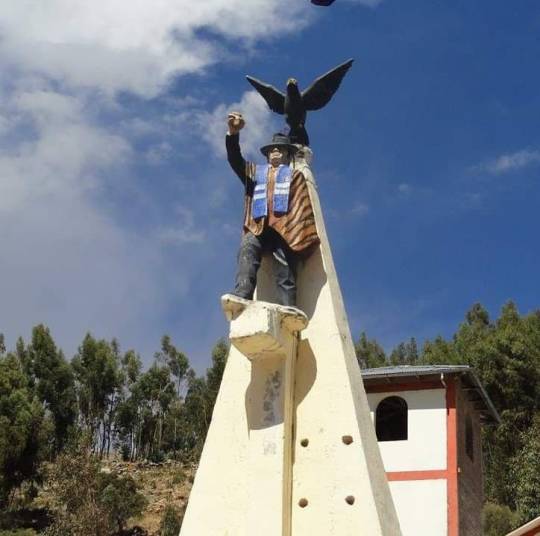
Obelisco que representa la gallardía de los héroes civiles de Huancho Lima.

En la puerta de la capilla de Huancho fue fusilado el héroe civil Evaristo Corimayhua Carcasi.

José Luis Ayala Olazával, al pie de la tumba del ideólogo y líder, Carlos Condorena Yujra.
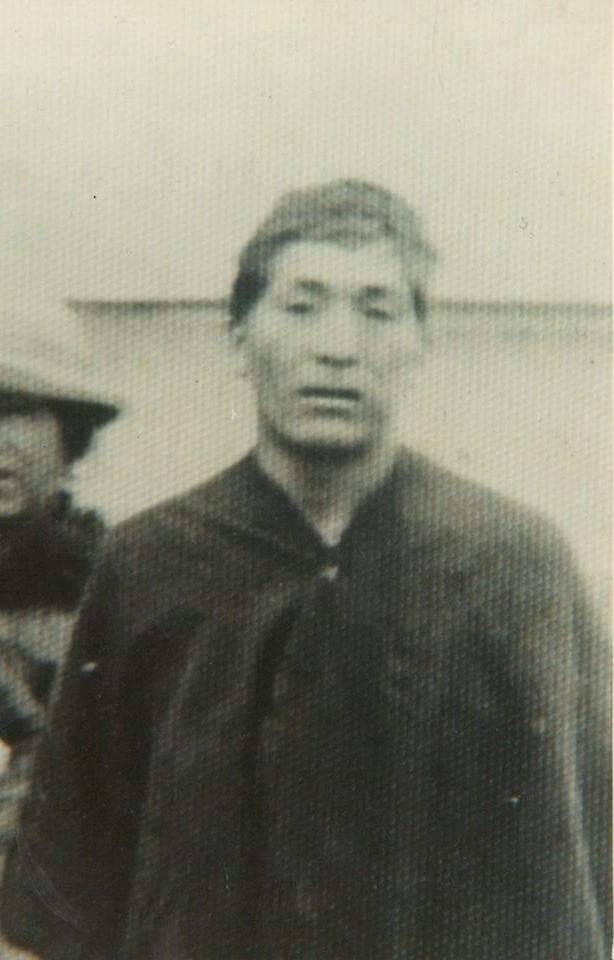
Carlos Condorena Yujra, fue Presidente de la Nueva República Aymara Tawantinsuyana del Perú.

Mariano Pacco Mamani, líder indiscutible de la gesta heroica de 1923.

Antonio Francisco Luque Luque, héroe civil de Huancho Lima.

Mariano Larico Yujra, canillita de José Carlos Mariátegui.

Mariano Luque Corimayhua, fundó la Escuela de Aña Aña en Huancho.
F. Tapia dirigiendo la palabra al gobierno en representación de los componentes del 5 Congreso Indígena 1925 Lima. Carlos Condorena Yucra luce con su pantalón de bayeta de color blanco.
0 notes
Text
Check out this fascinating video later today
Peruvian cinema, with its rich tapestry of storytelling and unique cultural perspectives, offers a captivating glimpse into the diverse heritage and social fabric of Peru. From its early beginnings to the contemporary era, Peruvian filmmakers have used cinema as a powerful medium to explore historical events, social issues, and personal narratives. In this extensive article, we will delve into the world of Peruvian cinema, exploring its history, notable filmmakers, significant films, thematic focus, and its contribution to the country's cultural identity.Origins and Development of Peruvian Cinema:Trace the origins of Peruvian cinema and its evolution over the years. From the pioneering works of early filmmakers such as José A. Céspedes and Augusto R. Tamayo to the establishment of film production companies and the growth of the industry, explore the milestones that have shaped Peruvian cinema.The Cultural and Social Context:Examine the cultural and social context that influences Peruvian cinema. Explore how historical events, political movements, and social issues have provided a backdrop for filmmakers to tell stories that reflect the realities and challenges faced by Peruvian society. Discuss the themes of identity, inequality, indigenous cultures, and historical memory that often emerge in Peruvian films.Notable Peruvian Filmmakers:Celebrate the visionary filmmakers who have made significant contributions to Peruvian cinema. From the influential works of Armando Robles Godoy and Francisco Lombardi to the contemporary voices of Claudia Llosa and Gianfranco Annichini, explore their unique storytelling styles, thematic choices, and their impact on the national and international stage.Themes and Narratives:Explore the recurring themes and narratives that characterize Peruvian cinema. From the exploration of identity and belonging to the examination of social injustices, poverty, and political upheavals, Peruvian films often provide a poignant and introspective portrayal of the country's complex realities. Discuss how these themes contribute to a deeper understanding of Peruvian culture and society.Representation of Indigenous Cultures:Highlight the representation of indigenous cultures in Peruvian cinema. Explore how filmmakers have shed light on the rich traditions, struggles, and resilience of indigenous communities in Peru. Discuss the importance of showcasing diverse perspectives and preserving cultural heritage through the medium of film.Landscapes and Locations:Appreciate the breathtaking landscapes and unique locations that serve as backdrops for Peruvian films. From the majestic Andes mountains to the mystical Amazon rainforest and the vibrant urban landscapes of Lima, Peru's diverse geography provides a visually stunning canvas for filmmakers to weave their narratives.Film Festivals and Awards:Examine the role of film festivals and awards in promoting Peruvian cinema. Explore the significance of festivals such as the Lima Film Festival and the Biennial of Peruvian Cinema in showcasing local talent, fostering industry connections, and celebrating the best of Peruvian filmmaking.Challenges and Opportunities:Discuss the challenges and opportunities faced by Peruvian cinema. Explore the impact of limited funding, distribution challenges, and the need for increased international recognition. Highlight the emergence of new voices, the growth of independent filmmaking, and the potential for collaborations and co-productions to strengthen the industry.Peruvian Cinema and Cultural Identity:Examine the connection between Peruvian cinema and the country's cultural identity. Discuss how films serve as a reflection of the collective memory, cultural heritage, and societal aspirations of the Peruvian people. Explore the role of cinema in shaping national narratives and fostering a sense of pride and belonging.Future Prospects:Look ahead to the future of Peruvian cinema and the opportunities for growth and expansion. Based on materials from xnxx young girls
0 notes
Text
Fallecimiento de Luis Francisco Tumi Guzmán, doctorando del GRISO
Fallecimiento de Luis Francisco Tumi Guzmán, doctorando del GRISO
El pasado sábado 5 de marzo nos llegaba desde Lima (Perú) la triste noticia del fallecimiento de Luis Francisco Tumi Guzmán, quien en la actualidad estaba realizando su tesis doctoral Historia, imaginario y ficción en la película «Rosa Mística» (2018), de Augusto Tamayo, bajo la dirección de los profesores Ignacio Arellano y Carlos Mata Induráin, integrado en los proyectos del Grupo de…

View On WordPress
#Augusto Tamayo#Departamento de Humanidades de la Universidad del Pacífico#Elio Vélez Marquina#Grupo de Investigación Siglo de Oro (GRISO)#Luis Francisco Tumi Guzmán#Necrológica#Rosa Mística#Santa Rosa de Lima#Universidad del Pacífico
0 notes
Photo

Hermosa noche. Hoy nos acompañó el reconocido cineasta Augusto Tamayo, un lujo. Una tertulia rodeado de amigos, charlando sobre el arte, cine y literatura peruana 🤗 https://www.instagram.com/p/CgGp-2-gU0Y/?igshid=NGJjMDIxMWI=
0 notes
Text

MAY - 05 - (AÑO 1887) - UN DÍA COMO HOY – EN LIMA, PERÚ, SE CREA LA ACADEMIA PERUANA DE LA LENGUA.
La Academia Peruana de la Lengua (APL) es una institución cultural que agrupa a literatos, escritores, poetas, lingüistas y científicos, expertos en el uso del idioma español en el Perú. Es miembro colectivo de la Asociación de Academias de la Lengua Española.
Fue establecida en Lima el 5 de mayo de 1887 por Ricardo Palma, aún el 30 de agosto realizó su primera función pública en el salón de actos de la Universidad Nacional Mayor de San Marcos, cuando se eligió como primer presidente a Francisco García Calderón, expresidente del Perú.
Si bien es cierto que se inauguró en 1887, su inicio fue pospuesto a causa de la Guerra del Pacífico, ya que durante la ocupación chilena de Lima gran parte de los libros de la Biblioteca Nacional fueron sustraídos y llevados a Chile como botín de guerra; este suceso forzó que Ricardo Palma priorice la reconstrucción de la Biblioteca dejando de lado la idea de inaugurar años antes la APL.
A García Calderón le sucede Ricardo Palma, primero como presidente y luego como director. Palma fue un valiente defensor de los peruanismos, que expuso en sus libros Papeletas lexicográficas y Neologismos y americanismos, además de luchar contra la Real Academia Española para que los acepte.
Entre sus miembros se encuentra Mario Vargas Llosa, galardonado con el Premio Cervantes (1994) y con el Premio Nobel de Literatura (2010), quien además tiene un sillón en la Real Academia Española. Pero junto a este insigne nombre de la literatura hispnoamericana, también fueron miembros de renombre: Víctor Andrés Belaúnde, Guillermo Hoyos Osores, Augusto Tamayo Vargas, Luis Jaime Cisneros, además Aurelio y Francisco Miró Quesada.
En el terreno de la lingüística quechua relacionada al castellano del Perú, participa Rodolfo Cerrón Palomino, y en peruanismos - sobre todo limeñismos y arcaísmos -, Martha Hildebrandt.
El poeta y traductor Ricardo Silva-Santisteban (Lima, 1941) fue el presidente de la institución desde 2014 hasta 2017. El actual presidente es Marco Martos Carrera, quien ha sido elegido hasta el año 2022.
La Academia - con sede en Lima - organizó el VIII Congreso Internacional de la Asociación de Academias (1980). [email protected]
0 notes
Text
Sobre la entrada en wikipedia
Recibí la notificación de que mi contribución fue borrada. Por ello decidí aprovechar este espacio para publicar la información que logre recuperar:
Medicina Romana
La presencia de la medicina en la Historia de Roma presenta etapas diferentes, también en directa relación con la historia política y la evolución de la ciencia; la primera de ellas fue de carácter pre-científico, o proto-científico, en la cual la curación estaba muy ligada a la magia, pese a lo cual, incluso en ella debe reconocerse también el intento de explicación a partir de la observación. Ejemplo son las múltiples referencias a las pestilentiae en la Roma republicana[1]
Considera como pre-científica, la medicina romana desde sus inicios, en los siglos IV a.C y III a.C, se halló Íntimamente ligada a un desarrollo esencialmente religioso y en su contenido es sencillo rastrear la influencia del conocimiento griego. Como en muchas otras culturas, la medicina sobrenatural romana sobrevivió con mucha popularidad varios siglos después de la caída del imperio romano. Su naturaleza esencialmente religiosa, le permitió integrarse con facilidad a las posteriores ideas del imperio bizantino y a las que prevalecieron durante toda la edad media.[2] Es importante señalar que el uso de productos provenientes de las plantas fue un rasgo sustancial en la medicina de la roma antigua, y en general en las culturas de la antigüedad, ejemplo de ello la mandrágora usada como anestésico en las cirugías.
Herencia Griega
En el año 293 a.C una terrible plaga, asoló Roma. Los ancianos encontraron una respuesta en los libros sibilinos, la respuesta fue buscar ayuda en el dios griego Asclepio, en Epidauro.[3] La leyenda cuenta que se envió una expedición especial en un navío que el dios aceptó y en el cual viajó adoptando la forma de una serpiente; cuando se halló frente a la ciudad de Roma abandonó la nave por si mismo, nadó hasta la isla de Tiber y retomó su figura terminando con el azote que apremiaba a los romanos. El primer médico griego en Roma fue Archagathus del Peloponeso. [4] En sus inicios, muchos de los médicos en Roma eran griegos, esto explica en gran medida la presencia de las ideas griegas en la medicina romana, Una parte importante de la tradición médica romana fue alimentada desde sus inicios por el griego Hipócrates. Sin embargo, con el discurrir del tiempo la teoría hipocrática de los humores empezó a ser criticada por corrientes como el metodismo. Puede considerarse la medicina como una fuente de la helenización y la romanización.
Avances de la medicina romana
Algunos de los progresos romanos en el campo médico estuvieron relacionados con la cirugía y la anatomía (aunque algunas prácticas relacionadas fueron condenadas en ocasiones, por Tertuliano y San Agustín por ejemplo, por considerar que alteraban la naturaleza armónica del cuerpo). Para comprender los aportes romanos en la medicina es indispensable lo que se ha recuperado de la obra de Aulio Corneilo Celso y Claudio Galeno. En general, algunas innovaciones romanas fueron la medicina militar y la medicina pública.
Aulio Cornelio Celso (ca. 30 a.C-50 a.C)
Enciclopedista y posible médico romano. De su obra se conoce De Medicina, un volumen de una obra más extensa, organizado en ocho libros y acorde a la división médica establecida por Hipócrates y Asclepio (Dieta, farmacología y cirugía) [5] Sus escritos tuvieron gran influencia en la medicina posterior, especialmente en la cirugía, aunque durante la Edad Media se le relegó siendo en esa época Plablo de Engina la autoridad médica primordial. Sus doctrinas quirúrgicas, constantemente cercanas a la hipocráticas, le garantizaron un lugar en los más importantes textos dedicados a esa disciplina durante el renacimiento. El libro octavo de De Medicina se inicia con un breve y preciso estudio del esqueleto humano concebido como mínimo de conocimientos anatómicos para exposición patológica tratada en el resto del libro. Realizó importantes aportes a la osteopatología, fundamentales para el tratamiento de lesiones craneales y la fractura apéchema (fractura en un lugar del cráneo diferente al lugar golpeado) [6]
Claudio Galeno (ca. 130 - 200 d.C)
Nació en Pérgamo, vivió en varias ciudades (entre ellas Alejandría y Corínto) pero finalmente se estableció en Roma. Fue un médico práctico, aprendió geometría de su padre y la aplicó en su teoría de la visión. Afirmó que la razón venía del cerebro y no del corazón. Escribió sobre la necesidad de conocer a los enfermos cuando están sanos y que para diagnosticar se precisa de observar y razonar.[7] Tiene el mérito de iniciar el conocimiento ordenado de la Anatomía Comparada y Topográfica basado en la observación.[8]
Medicina militar
El valentudinaria es la principal contribución romana a la medicina militar. En los campamentos, los valentudinaria (de valere, ‘tener salud’) aparecen por primera vez en la época de Augusto. La rehabilitación de soldados enfermos y heridos había cobrado importancia debido a las constantes guerras que el pueblo romano libro durante la República y el Imperio. Los valentudinaria se encontraban siempre situados dentro de los grandes campamentos de legión y cercanos a los limes (Conjunto de muralllas y torres dispuestas en las fronteras para la defensa). Presentaban todos gran uniformidad, tenía oficinas, quirófanos, salas de recepción para visitas, despensas, baños y lugares de higiene, como también, habitaciones para internos y personal. Se considera el antecesor de las más modernos instalaciones médicas. Aún hoy, se implementan las dos puertas para acceso al quirófano en todos los hospitales. El análisis de instrumentos quirúrgicos encontrados en los campamentos legionarios permite confirmar que no existieron diferencias entre el médico militar y el civil. [9]
Referencias
↑ Gozalbes, Enrrique; García, Inmaculada (2010). Entorno a la medicina romana en: Hispania Antiqua núm, 33-34. Ediciones Universidad de Valladolid.
↑ Pérez Tamayo, Ruy (2003). De la magia primitiva a la medicina moderna. México D.F: Fondo de Cultura Económica. ISBN 968-16-6948-7.
↑ Pérez Tamayo, Ruy (2003). «La medicina en el imperio Romano (siglos III a.C a VI d.C)». De la magia primitiva a la medicina moderna. México D.F: Fondo de cultura económica. p. 43.
↑ Soubiran, Andre; De Kearney, Jean (1963). El diario de la medicina. Barcelona: Luis de Caralt.
↑ «On Medicine - De medicina». World Digital Library.
↑ Conde Parrado, Pedro (2008). Por el orden de Celso: Aspectos de la influencia del De Medicina en la cirugía europea del Renacimiento. Granada: Dynamis
↑ Zamudio, Leonardo (2003). Hisoria de la medician: Galeno ayer y hoy. En: Rev Fac Med. México: UNAM
↑ Romero, A. et al (2011). Galeno de Pérgamo: Pionero en la historia de la ciencia que introduce los fundamentos científicos de la medicina. En: Análes Médicos vol. 56 núm. 4
↑ Monteagudo García, Luis (2000). La cirugía en el Imperio Romano. España: Anuario Brigantino, núm 23. p. 86-150
1 note
·
View note
Text
The future is now: Following the contributions by Jeff Koons and John Baldessari, Cao Fei (b. 1978) is the youngest and first Chinese artist ever to create a BMW Art Car. By employing augmented and virtual reality, the internationally acclaimed Chinese multimedia artist addresses the future of mobility such as autonomous driving, airborne cars and digitalization. In the presence of Dr Ian Robertson, Member of the Board of Management of BMW AG, and hundreds of invited guests, the reveal of BMW Art Car #18 was celebrated at the Minsheng Art Museum in Beijing on May 31.
Dr Ian Robertson, Member of the Board of Management of BMW AG: “We were thrilled by the decision of an independent jury of international museum directors to have nominated Cao Fei. Considered as a lucky number in China, her vehicle is the official 18th rolling sculpture of the collection. For her project, Cao Fei chose an unprecedented and immersive approach, empowering the viewer to engage with the artwork through cutting-edge technology. This is truly a BMW Art Car for the 21st century!”
Cao Fei commented upon her BMW Art Car: “To me, light represents thoughts. As the speed of thoughts cannot be measured, the #18 Art Car questions the existence of the boundaries of the human mind. We are entering a new age, where the mind directly controls objects and where thoughts can be transferred, such as unmanned operations and artificial intelligence. Which attitudes and temperaments hold the key to opening the gateway to the new age?”
The BMW Art Car #18 by Cao Fei
Cao Fei’s work is a reflection on the speed of change in China, on tradition and future. With her BMW Art Car project, she delves into a trajectory spanning thousands of years, paying tribute to Asia’s ancient spiritual wisdom as it swiftly spreads out into the third millennium. The multimedia artist approached the BMW Art Car in a way typical for her artistic practice, building a parallel universe. The body of work consists of three different components: a video focusing on a time traveling spiritual practitioner, augmented reality features picturing colorful light particles, accessible via a dedicated app (App Store: keyword “BMW Art Car #18”), and the BMW M6 GT3 racecar in its original carbon black. Paying tribute to the carbon fiber structure of the racecar chassis, Cao Fei’s holistic use of a non-reflective black incorporates the car into the possibilities of the digital world.
Within this concept, Cao Fei’s implementation of video art as well as augmented reality creates an environment of which the M6 GT3 is an essential part. In her video work, the practitioner executes spiritual movements, which echo in colorful streams of light. When the app is used within the premises of the car, these light swishes become an AR installation floating above and around the BMW M6 GT3 – involving the spectator as an interactive agent of participation. This narrative reflects on a traditional spiritual ceremony very common throughout Asia in which new objects such as automobiles are being blessed, in this case wishing good luck to car and driver. On a broader level, the light elements mirror what the eyes cannot see and the mind cannot picture.
During the course of over three years following her announcement, Cao Fei took part in a racing experience with female race driver Cyndie Allemann in Switzerland in 2015. During manifold visits to headquarters, she worked closely with BMW Group’s engineers, designers, and digital specialists. For her research, the artist also went on an extended BMW plant visit to Tiexi.
The Jury
The jury of the 18th BMW Art Car consisted of the following members: Richard Armstrong, Director, Solomon R. Guggenheim Museum (New York); Chris Dercon, then Director, Tate Modern (London); Juan Gaitán, Director, Museo Tamayo Arte Contemporáneo (Mexico City); Gabriele Horn, Director, Berlin Biennale; Udo Kittelmann, Director, Nationalgalerie Staatliche Museen zu Berlin; Dr. Matthias Mühling, Director, Städtische Galerie im Lenbachhaus (Munich); Hans-Ulrich Obrist, Artistic Director, Serpentine Gallery (London); Shwetal A. Patel, Kochi-Muziris Biennale (India); Beatrix Ruf, Director, Stedelijk Museum (Amsterdam); Bisi Silva, Director, The Centre for Contemporary Art (Lagos); Philip Tinari, Director, Ullens Center for Contemporary Art (Beijing) and Adam D. Weinberg, Director, Whitney Museum of American Art (New York).
Joint statement of the international jury on Cao Fei’s BMW Art Car project: “Cao Fei plays with many different dimensions in her artistic practice. In the international art world, she is well known for exploring virtual realities and digital platforms in her works, while eventually bringing her narrative back into the analogue world. We are not surprised that she picked a scenario that is on the one hand imaginary, even fictitious, but then on the other hand very concrete and physical.“
Quotes on the occasion of the World Premiere of BMW Art Car #18
The 18th BMW Art Car was revealed in the presence of Olaf Kastner (President and CEO of BMW Group, China Region), Jens Marquardt (BMW Motorsport Director), Augusto Farfus (BMW works driver) and Fan Di’an (President of China Central Academy of Fine Arts).
Olaf Kastner, President and CEO of BMW Group, Region China: “We are proud to present the first BMW Art Car designed by a Chinese artist, Cao Fei, who is also by far the youngest. She is a solid example of BMW Group’s commitment to promote the new emerging generation of Chinese artists. We are not only active in shaping the future of mobility, but also in developing strong social connections with China through cultural engagement initiatives, dating back as early as 11 years ago. China is undergoing huge and rapid developments, especially in the digital landscape. The 18th BMW Art Car pays tribute to the flourishing changes in the Chinese society.”
Jens Marquardt, BMW Motorsport Director: “The 18th BMW Art Car is perfectly suited to this era. Cao Fei took the logical step of creating the first ever digital Art Car. The augmented reality experience makes this BMW M6 GT3 unique. For everyone involved at BMW Motorsport it was both exciting and fascinating to work with Cao Fei and her team on this project. This makes 2017 a very special year in the history of BMW Art Cars. First, the BMW M6 GTLM Art Car of John Baldessari took to the track in Daytona, at the end of the season comes Art Car #18 by Cao Fei in Macau. This makes the tradition of BMW Art Cars livelier than ever.”
Augusto Farfus, BMW works driver: “It’s a huge honour for me to race Cao Fei’s BMW Art Car, the 18th member of the BMW Art Car Collection. I’m extremely proud that I get the chance to drive my second Art Car this year. This is absolutely unique for a racing driver. I’m really looking forward to diving deeper into this project and learning more about the artist’s ideas and her philosophy behind it.”
Fan Di’an, President of China Central Academy of Fine Arts: “Cao Fei’s achievement in creating the 18th BMW Art Car through augmented reality as a multimedia installation resonates with the rapid development and huge transformation of China over the past decades, such as globalization, urbanization and digitalization, which drives the flourishing development of contemporary art in China. In the increasingly digitalized world, technology has become an important means for artists to create. I’m delighted to see Chinese artists are at the forefront of digital art.”
The BMW M6 GT3 on the racetrack
The BMW M6 GT3 has been the top model in the BMW Motorsport customer racing line-up since 2016. The car is powered by a 4.4-litre V8 engine with M TwinPower Turbo Technology, generating 585 hp – with the whole car weighing less than 1,300 kilograms. Technical characteristics of the BMW M6 GT3 are also the drive concept, six-speed sequential racing transmission, and high-performance motorsport electronics. In 2016 the GT car got off to a flying start, proving to be a race winner from the word go. Maxime Martin (BEL), Alexander Sims (GBR) and Philipp Eng (AUT) drove the BMW M6 GT3 to victory in the 24-hour race of Spa-Francorchamps (BEL). In addition, private BMW teams and drivers collected many more victories and titles over the course of the season with this challenger. The GTLM version of the car is competing in the IMSA WeatherTech SportsCar Championship. Sims, Bill Auberlen (USA), Augusto Farfus (BRA) and Bruno Spengler (CAN) took turns racing John Baldessari’s BMW M6 GTLM Art Car during the 24 Hours of Daytona (USA). Again, it will be up to Farfus to race yet another Art Car, this time designed by Cao Fei, at the FIA GT World Cup in Macau (CHN).
Dimensions:
Length: 4,944 mm
Width: 2,046 mm
Wheelbase: 2,901 mm
Weight: under 1,300 kg (without driver, depending on regulations)
Engine:
Model: Based on the S63 production engine and slightly modified
for the specific requirements of motorsport;
with M TwinPower Turbo Technology
Type: V8
Capacity: 4,395 cc
Performance: up to 585 hp (depending on classification)
Oil supply: Oil system, based on dry sump,
specifically developed by BMW Motorsport
Top speed: approx. 280 km/h
The BMW Art Car Collection
Since 1975, a total of 19 artists from all over the world have created BMW Art Cars on the basis of contemporary BMW automobiles. The collection was inaugurated when French racecar driver and art aficionado Hervé Poulain in collaboration with the then current BMW Motorsport Director Jochen Neerpasch asked his artist friend Alexander Calder to design a car. The result was a BMW 3.0 CSL, which in 1975 was raced at the 24 Hours of Le Mans and became an instant favorite with the public: the BMW Art Car Collection was born. The home of the BMW Art Cars is the BMW Museum in Munich. In addition, they travel internationally for display in exhibitions and museums.
In November 2015, BMW Group announced two artists to create the next BMW Art Cars at the Solomon R. Guggenheim Museum, New York. In addition to multimedia artist Cao Fei, American icon John Baldessari designed a BMW M6 GTLM, both joining the ranks of: Alexander Calder, Frank Stella, Roy Lichtenstein, Andy Warhol, Ernst Fuchs, Robert Rauschenberg, M. J. Nelson, Ken Done, Matazo Kayama, César Manrique, A. R. Penck, Esher Mahlangu, Sandro Chia, David Hockney, Jenny Holzer, Olafur Elíasson and Jeff Koons. After its world premiere on November 30, 2016, during Art Basel in Miami Beach, the BMW Art Car by John Baldessari competed at the legendary 24 Hours of Daytona from January 28 to 29, 2017.
Over the summer, her multimedia installation will be displayed at the BMW Experience Shanghai, a brand and driving experience center, before her BMW M6 GT3 needs to prove itself on the racetrack of the FIA FT World Cup in Macau on November 17-19, 2017. A virtual experience of her BMW Art Car will also be on display at the UBS Forum during Art Basel in Basel in June 2017.
About Cao Fei
Born in 1978 in Guangzhou, Cao Fei is one of the most innovative young Chinese artists to have emerged onto the international scene. Currently living in Beijing, she mixes social commentary, popular aesthetics, references to Surrealism, and documentary conventions in her films and installations. Her works reflect on the rapid and chaotic changes that are occurring in Chinese society today. She exhibited her works and projects in Serpentine Gallery, Tate Modern (London); New Museum, Guggenheim Museum, MoMA (New York); Palais de Tokyo and Centre Pompidou (Paris). Cao Fei’s recent projects in 2016 include her first retrospective at MoMA PS1. Furthermore, Cao Fei received the Chinese Contemporary Art Award (CCAA) Best Young Artist Award in 2006 and Best Artist Award in 2016; Piedra de Sal Award at Cuenca Biennale in 2016.
About BMW Group’s Cultural Commitment
For almost 50 years now, the BMW Group has initiated and engaged in over 100 cultural cooperations worldwide. The company places the main focus of its long-term commitment on contemporary and modern art, classical music and jazz as well as architecture and design. In 1972, three large-scale paintings were created by the artist Gerhard Richter specifically for the foyer of the BMW Group’s Munich headquarters. Since then, artists such as Andy Warhol, Jeff Koons, Daniel Barenboim, Jonas Kaufmann and architect Zaha Hadid have co-operated with BMW. In 2016 and 2017, female artist Cao Fei from China and American John Baldessari created the next two vehicles for the BMW Art Car Collection. Besides co-initiatives, such as BMW Tate Live, the BMW Art Journey and the “Opera for All” concerts in Berlin, Munich and London, the company also partners with leading museums and art fairs as well as orchestras and opera houses around the world. The BMW Group takes absolute creative freedom in all its cultural activities – as this initiative is as essential for producing groundbreaking artistic work as it is for major innovations in a successful business.
About BMW Group’s commitment to culture in China
BMW Group has always been committed to fulfilling corporate social responsibility through cultural engagement in China contributing to the development of Chinese art and culture.
In China, BMW Group kicked off BMW Culture Journey in 2007 to safeguard and promote Chinese cultural heritage. In the past decade, the initiative has visited six major eco-cultural preservation zones and over 270 intangible cultural heritage items and has donated over 16 million RMB to support 90 projects in urgent need of safeguarding.
The Tiexi plant in China is one of the world’s most advanced and sustainable automobile plants, which is also known as an “art factory”. There are many displays of artworks throughout, all of which are the result of a project called “10+10”, a cultural engagement program jointly initiated by the BMW Group, BMW Brilliance, LuXun Academy of Fine Arts and Akademie der Bildenden Künste München, to reflect on the relationship between industry, nature and humans under different cultural contexts.
The all-new BMW Brand Experience Center in Shanghai is a creative institution that harmoniously combines the strong BMW identity with Chinese elements, and offers free access to the public. The institution has a dedicated area to showcase the BMW Art Cars and allows the public to design their own art cars virtually. In addition to BMW branding events and experiential activities, it also hosts various programs regularly, e.g. innovation talks and culture journey workshops.
BMW | Art Car reloaded The future is now: Following the contributions by Jeff Koons and John Baldessari, Cao Fei (b. 1978) is the youngest and first Chinese artist ever to create a BMW Art Car.
1 note
·
View note
Text

#ProyeccionDeVida
📣 CINE PERUANO. EDICIÓN BICENTENARIO, presenta:
📼 En el mes patrio para exhibir se ofrece lo más reciente del cine nacional en conmemoración por los 200 años de la consolidación de la Independencia del Perú. A través de doce largometrajes estrenados entre el 2023 y 2024 de forma comercial y alternativa, películas beneficiarias de los Estímulos Económicos para la Cultura en sus diferentes líneas de apoyo.
🎞 Organiza: Dirección del Audiovisual, la Fonografía y los Nuevos Medios y Ministerio de Cultura del Perú.

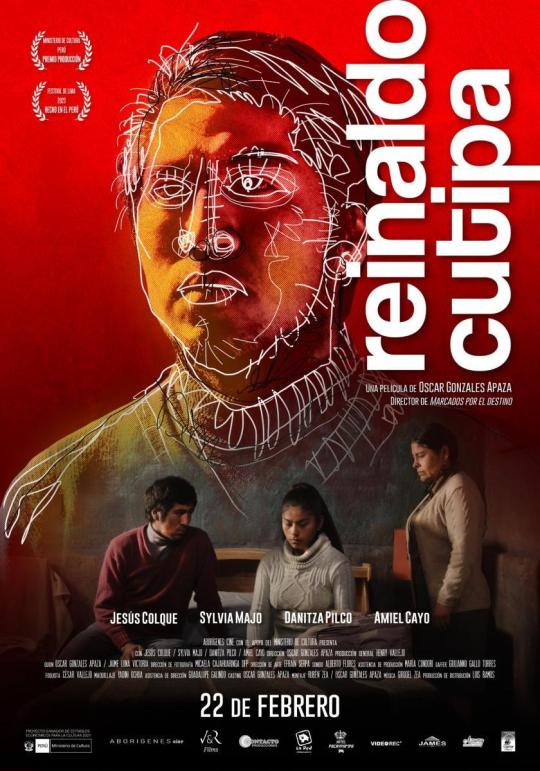
📝 CARTELERA:
📆 Martes 16 de julio
🕕 6:00pm. “Hogar” (76´-Documental-2023) Dirección: Jano Burmester (Perú).
🕗 8:00pm. “Carnaval” (75´-Documental-2024) Dirección: José Alberto Osorio y Gabriel Tejada (Perú).
📆 Miércoles 17 de julio
🕕 6:00pm. “La decisión de Amelia” (96´-Drama/Enfermedad/Vejez/Madurez-2023) Dirección: Francisco Lombardi (Perú).
🕗 8:00pm. “La herencia de Flora” (133´-Drama/Biográfico/Histórico/Siglo XIX-2024) Dirección: Augusto Tamayo San Romásn (Perú).

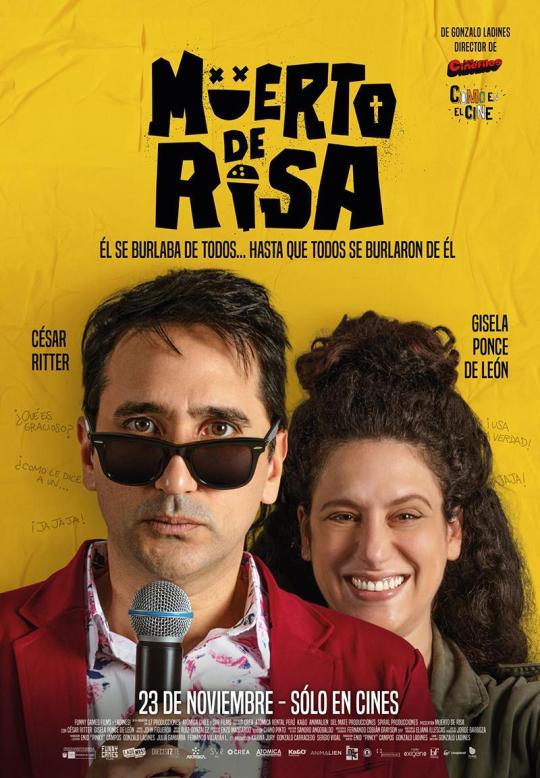
📆 Jueves 18 de julio
🕕 6:00pm. “Tayta Shanti” (76´-Drama-2024) Dirección: Hans Matos (Perú).
🕗 8:00pm. “La Pampa” (106´-Drama/Thriller/Prostitución/Desapariciones-2023) Dirección: Dorian Fernández-Moris (Perú-España-Chile).
📆 Viernes 19 de julio
🕕 6:00pm. “El caso Monroy [Ronnie Monroy ama a todas]” (95´-Drama-2022) Dirección: Josué Méndez (Perú-Argentina).
🕗 8:00pm. “Reinaldo Cutipa” (118´-Drama/Familia/Vida Rural-2024) Dirección: Oscar Gonzáles Apaza (Perú-España-Chile).

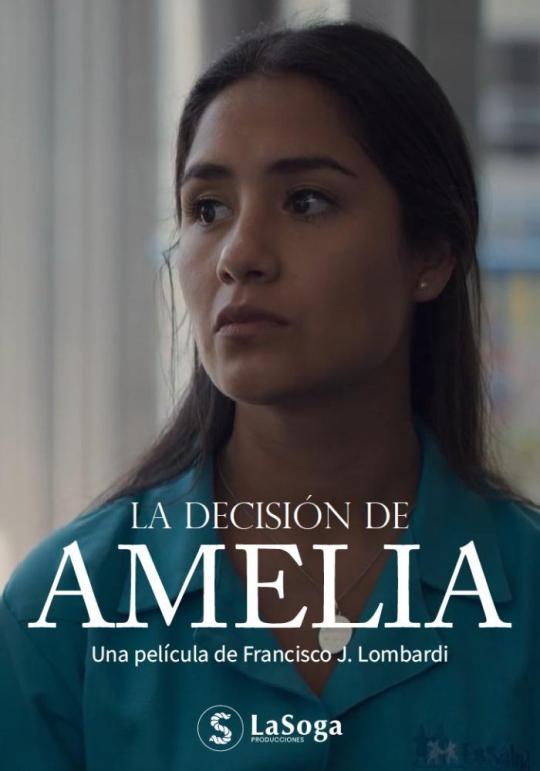
📆 Sábado 20 de julio
🕔 5:00pm. “Muerto de risa” (90´-Comedia/Stand-Up/Televisión-2023) Dirección: Gonzalo Ladines (Perú-Chile).
🕖 7:00pm. “Viejas Amigas” (100´-Comedia/Drama/Amistad/Vejez-2024) Dirección: Fernando Villarán (Perú).
📆 Domingo 21 de julio
🕔 5:00pm. “Pirú, un viaje de oro” (116´-Comedia/Drama/Vida Rural-2023) Dirección: Bismarck Rojas (Perú).
🕖 7:00pm. “Historias de Shipibos” (117´-Drama/Familia/Vida Rural/Película de Episodios-2023) Dirección: Omar Forero (Perú).


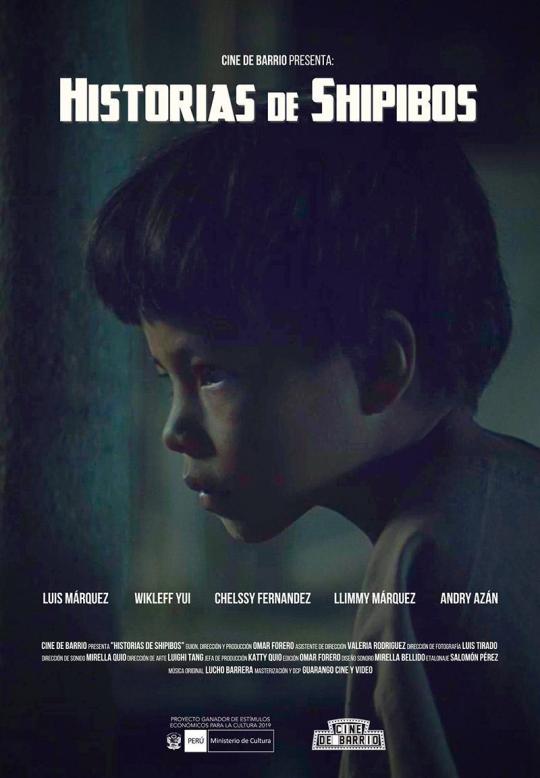
📽 PROYECCIONES:
📆 Del 16 al 21 de Julio
🎥 Sala Armando Robles Godoy del Museo de la Nación (av. Javier Prado Este 2465 - San Borja)
🚶♀️🚶♂️ Ingreso libre.
👪 El Dato: Aforo Limitado (94 personas).
👀 A tener en cuenta: Películas recomendadas para mayores de catorce años (14+)
0 notes
Text

La Herencia de Flora la película dirigida por Augusto Tamayo lanza afiche oficial y confirma su estreno para el 7 de marzo http://dlvr.it/T19v7S
0 notes
Text
97 AÑOS DE LA SUBLEVACIÓN CAMPESINA DE HUANCHO LIMA #huanchoLima
Fernando Chuquipiunta
La llamada sublevación campesina de Wancho Lima, fue registrada por José Carlos Mariátegui, Jorge Basadre, Wilfredo Kapsoli, Manuel Scorza, Pablo Macera, José Tamayo Herrera, Teobaldo Loayza Obando, Augusto Ramos Zambrano y José Luis Rénique. La frondosa documentación data desde la época de los mensajeros, quienes viajaron a Lima para reclamar al presidente Manuel Gonzáles Candamo, acerca de los abusos de los gamonales de Huancané contra los campesinos quechuas y aymaras.
Debido al liderazgo de Carlos Condorena Yujra, llamado también Carlosín Condorena, cuyo verdadero nombre era Carlos Condori Yujra, es que se formó un grupo de personas decididas a acabar con el gamonalismo en el departamento de Puno. Evaristo Corimayhua Carcasi, Mariano Luque Corimayhua, Pedro Nina Cutipa Corimayhua, Melchor Cutipa Luque, Antonio Francisco Luque Luque, Mariano Mercedes Pacco Mamani y Rita Puma, se convirtieron en líderes de un movimiento que, además, se propuso establecer una educación bilingüe, como recuperar las tierras arrebatadas por los gamonales a las comunidades campesinas.
En un principio contaron con la simpatía del presidente Augusto Bernandino Leguía y Salcedo, quien auspiciaba desde el gobierno un indigenismo oficial y subalterno. Los dirigentes de Huancho decidieron entonces, construir una ciudad con los mismos planos urbanos de Lima y le pusieron el nombre de Huancho Lima, capital de la República Aymara Tahuantisuyana y lugar emblemático de la reivindicación de los derechos ciudadanos de la cultura aymara. Construyeron locales para ministerios, escuelas, mercados, calles y avenidas.
Todo estaba decidido para atacar a Huancané y diezmar a la población. Pero ese hecho fue impedido por las lluvias que provocaron que el río Huancané creciera, arrastrando muchas balsas llenas de personas. El domingo 16 de diciembre de 1923, a las 10 de la mañana, muchas personas murieron a causa de las balas de fusiles y ametralladoras, también se produjo un gran incendio de todas las casas de Huancho.
Nunca se supo cuántos muertos hubo. El éxodo fue enrome y ese acontecimiento ha sido registrado magistralmente por el escritor huancaneño José Luis Ayala Olazával, quien ha publicado: Wancho Lima (cronivela), Yo fui canillita de José Carlos Mariátegui. (Auto) biografía de Mariano Larico Yujra (testimonio), Fusilamiento y resurrección de Mariano Paqo (novela corta), Celebración cósmica de Rita Puma (poesía), El presidente Carlos Condorena Yujra (historia) y Saturnino Corimayhua. Testimonio de lucha de un campesino del siglo XX (entrevista).
Además, sin la contribución de Vicente y Julio Mendoza Díaz, Leonidas Cuentas Gamarra, Juan Luis Ayala Loayza, Felipe Sánchez Huanca, Augusto Ramos Zambrano, Leoncio Mamani Coaquira, Julio Volodia Mendoza Aparicio, pero especialmente de José Luis Ayala Olazával, sin duda que se hubiera perdido tanta información histórica. Las nuevas generaciones tienen derecho a conocer el pasado para que no se repitan los mismos errores. Finalmente, no hay pueblo sin historia porque sin ella no es posible, edificar un futuro distinto al oprobioso pasado que se ha vivido.



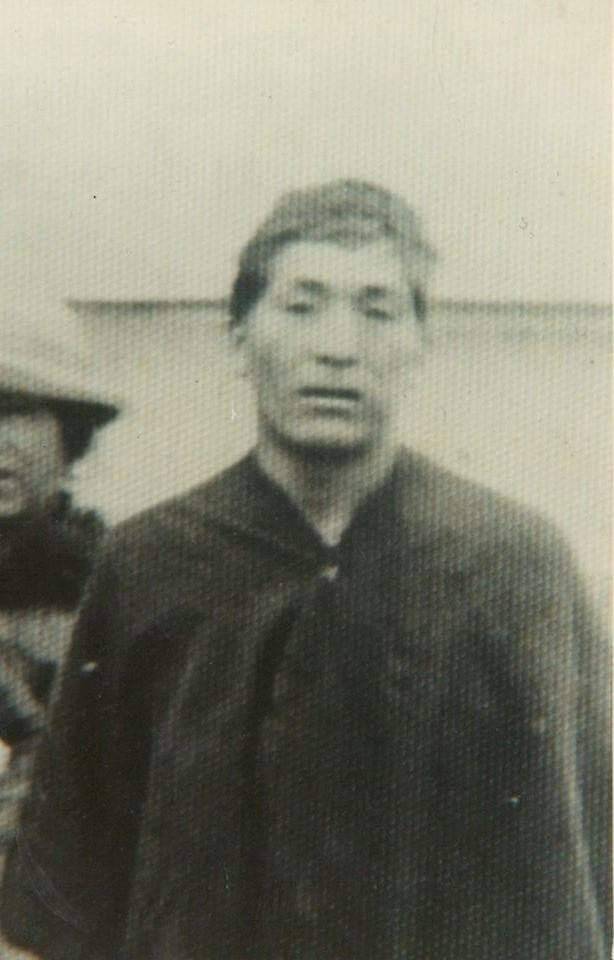
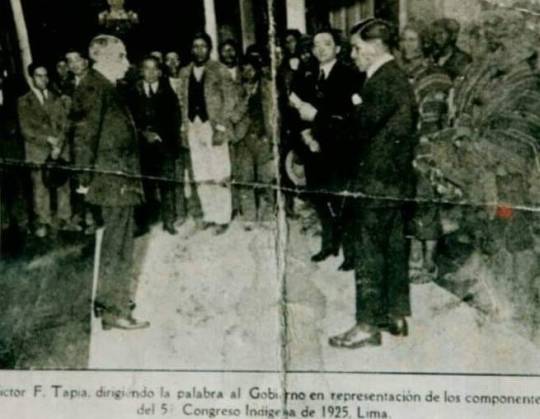
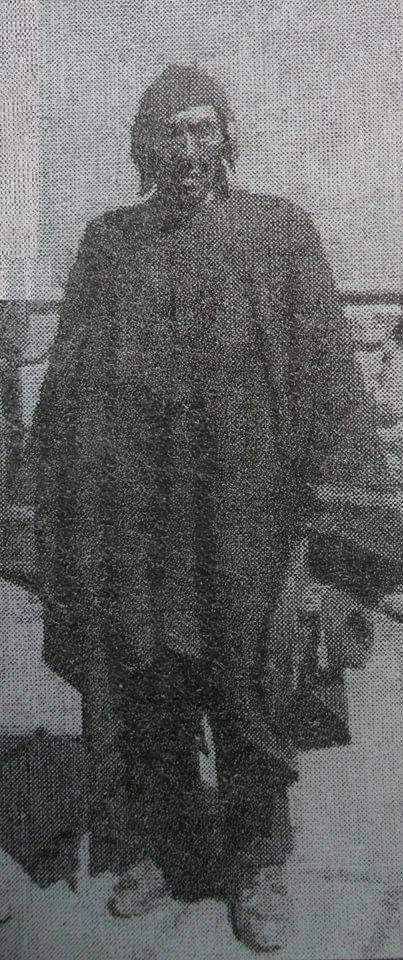
2 notes
·
View notes
Text
HAPPY BIRTHDAY SEPTEMBER 2018 CELEBRANTS!!

DAY DOCTORS NAME DEPARTMENT 1 DR. TINIO, BERNARD GIL O. OPHTHALMOLOGY 1 DR. MATANGUIHAN, REY T. OPHTHALMOLOGY 2 DR. EDUSMA-DY, REGINA T. MEDICINE 2 DR. SABAS, MARY HELEN E. RADIOLOGY 3 DR. AVECILLA, GUIA R. DERMATOLOGY 3 DR. ABAD SANTOS, SALVADOR M. MEDICINE 3 DR. SANCHEZ, JOSE T. MEDICINE 3 DR. CABRERA, BENJAMIN GERARDO G. OPHTHALMOLOGY 3 DR. FERNANDEZ, RICARDO O. OTOLARYNGOLOGY 3 DR. CONTRERAS, JOEL REGINO E. PHYSICAL MEDICINE & REHABILITATION 4 DR. LU, HENRY U. NEUROLOGICAL SCIENCES 4 DR. ARGUELLES, VICENTE Q. SURGERY 4 DR. BAUTISTA, EDUARDO R. SURGERY 5 DR. DE JESUS, GERARD THOMAS O. ANESTHESIOLOGY 5 DR. SANTOS, SUZANNE V. MEDICINE 5 DR. SANTIAGO, CARLOS FRANCIS A. NEUROLOGICAL SCIENCES 5 DR. DEL ROSARIO, ROSARIO R. PEDIATRICS 5 DR. ESTRADA, RAMON S. SURGERY 6 DR. DIMAYUGA, JOSE GIOVANNI E. DERMATOLOGY 6 DR. CANLAS-ESTRELLA, KATRINA M. DERMATOLOGY 6 DR. PEDREGOSA, GERARDO S. MEDICINE 6 DR. SAN JUAN, FILOMENA S. OBSTETRICS & GYNECOLOGY 7 DR. MACALINTAL-CANLAS, REGINA A. NEUROLOGICAL SCIENCES 7 DR. BAUTISTA, MARIO BENITO F. OBSTETRICS & GYNECOLOGY 7 DR. PERRERAS, MARIA ANGELA NICOLE S. PEDIATRICS 7 DR. ROJAS, FILADELFO JUAN ALBERTO III M. SURGERY 8 DR. VILLARUBIN, AUGUSTO O. MEDICINE 8 DR. ANSON, JOSE MARIA L. MEDICINE 8 DR. BANZON, MARCELINO D. OPHTHALMOLOGY 8 DR. SANTOS, CHRISTINE THERESE A. OPHTHALMOLOGY 8 DR. ONGSIAKO-ISABELA, CARMELA H. OPHTHALMOLOGY 9 DR. CABRAL-PRODIGALIDAD, PATRICIA ANNE I. MEDICINE 9 DR. RAMOS, CLAVER P. MEDICINE 9 DR. MEDINA, CLEOFE B. OBSTETRICS & GYNECOLOGY 9 DR. FELIX, ADORA CHRISTINE A. OBSTETRICS & GYNECOLOGY 9 DR. OLONAN, BIANCA NIKKOLA N. RADIOLOGY 9 DR. DIAZ, RAMON JR. I. SURGERY 10 DR. SALONGA-QUIMPO, RHEA ANGELA M. PEDIATRICS 10 DR. DAMASO, DENNIS G. SURGERY 10 DR. BALTAZAR, WILMA A. SURGERY 11 DR. CHING-NARCISO, JAMIE LYNNE G. OPHTHALMOLOGY 11 DR. BENITO, MA. LYN R. PEDIATRICS 12 DR. WASSMER, GIA D. MEDICINE 12 DR. DE LUNA, MARIETA B. MEDICINE 12 DR. KATIGBAK, GENEVIEVE C. MEDICINE 12 DR. ALCALA, FERDINAND G. MEDICINE 12 DR. RELOZA, VICENTE ANTONIO A. PHYSICAL MEDICINE & REHABILITATION 13 DR. TUPASI, THELMA E. MEDICINE 13 DR. FAJARDO-HERNANDEZ, SHEILA MARIE U. OBSTETRICS & GYNECOLOGY 13 DR. SUNTAY, MARCUS LESTER R. SURGERY 14 DR. DASIG, D. DARWIN A. NEUROLOGICAL SCIENCES 14 DR. BARRETTO, BENEDICT L. SURGERY 16 DR. ESGUERRA, ERIBERTO F. MEDICINE 16 DR. TAMBUNTING, MA. MILAN P. MEDICINE 16 DR. SANTIAGO, ERIC HUGHES A. MEDICINE 16 DR. OLIVA, ANDREA MARIE M. MEDICINE 16 DR. LAZARO, PACITA S. OBSTETRICS & GYNECOLOGY 16 DR. GOZON-FRANCISCO, MARIA LIZA P. OBSTETRICS & GYNECOLOGY 17 DR. RACOMA, JEFFREY NAZ B. OPHTHALMOLOGY 17 DR. CRUZ, BENEDICT R. SURGERY 18 DR. QUETUA, ANA MAE Q. MEDICINE 18 DR. CALIXTO-MERCADO, KAREN SOPHIA M. PEDIATRICS 19 DR. CESARIO, RODRIGO G. MEDICINE 20 DR. CAPISTRANO, MA. EVELYN T. OBSTETRICS & GYNECOLOGY 20 DR. CAMPOS, SUSANA P. PEDIATRICS 20 DR. HERRERA, RODOLFO B. SURGERY 21 DR. AYPA, NOEL S. ANESTHESIOLOGY 21 DR. TAMAYO, MA. BELEN E. MEDICINE 21 DR. MERIALES, MA. ZITA Z. OPHTHALMOLOGY 21 DR. GUSTILO, RAMON B. ORTHOPEDIC SURGERY 22 DR. CHOTANGCO, MARIA ELLEN C. OBSTETRICS & GYNECOLOGY 22 DR. CORDERO, JOSEPH A. SURGERY 23 DR. HERNANDEZ, ERWIN P. DENTISTRY 24 DR. LLAMANZARES, TEODORO P. OTOLARYNGOLOGY 24 DR. LEUS, AURELIA G. PEDIATRICS 24 DR. SIA, JAN HAROLD D. PEDIATRICS 24 DR. ALCANTARA, GERALDINE V. PEDIATRICS 25 DR. DIÑO-LIM, MARIEJECELLE P. DENTISTRY 25 DR. REYES, KARL MICHAEL G. SURGERY 27 DR. LLAMAS, EUSEBIO ANTONIO G. OTOLARYNGOLOGY 28 DR. SANTOS-ABES, MARIA PATRICIA G. PEDIATRICS 29 DR. LOPEZ, GARY A. MEDICINE 29 DR. VILLAVICENCIO, MA. LUISA J. PEDIATRICS 30 DR. LLEGO, SHERWIN A. DERMATOLOGY 30 DR. SANSANO, OLIVER M. MEDICINE 30 DR. SERNA-SANTOS, GENEVERE A. RADIOLOGY 30 DR. TORRES, CARLOS RAMON JR N. SURGERY 30 DR. PADLAN, MICHAEL C. SURGERY
via Blogger https://ift.tt/2wERZXF
0 notes
Video
youtube
PELÍCULA ROSA MÍSTICA DE AUGUSTO TAMAYO SE ESTRENARÁ EL 30 DE AGOSTO A NIVEL NACIONAL La película es escrita y dirigida por Augusto Tamayo y patrocinada por Telefónica/ Movistar. Narra los momentos más importantes de la vida de la mujer peruana mas venerada en el mundo que construyó su destino defendiendo sus convicciones, y su personal búsqueda espiritual en el Perú del siglo XVII.
0 notes